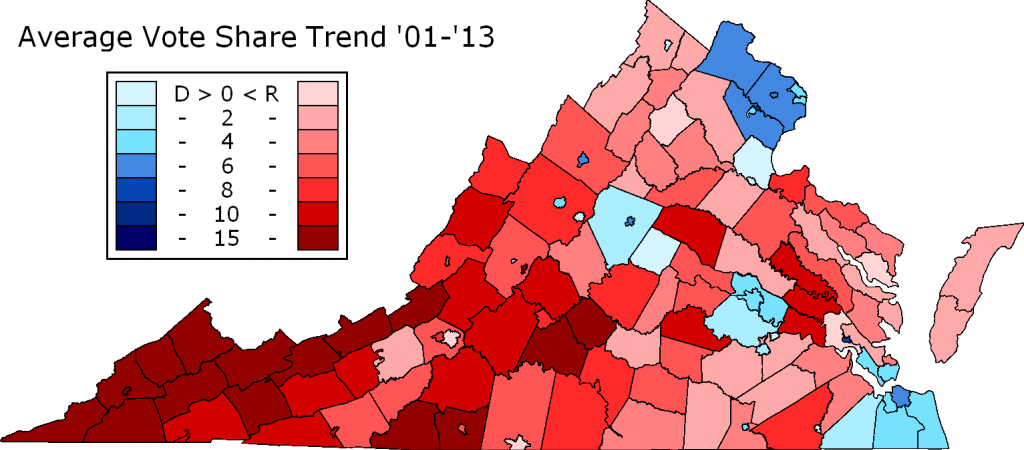( – promoted by lowkell)
(Welcome to this twelve part series looking at the challenges, obstacles, and future possibilities of Virginia Democrats. If you’ve missed past diaries, follow these links: Day One, Competitive Districts. Day Two, Turnout Problems. Day Three, Past Mistakes. Day Four, Downstate Democrats. Day Five, Unchallenged Incumbents. Day Six, Present Opportunities. And as always, at the end of the diary there is a poll! Thank you for reading, and have a happy 2014!)
On the seventh day of Christmas, the Commonwealth of Virginia gave to me …
Encouraging signs of growing Democratic trends in the state’s largest counties and most competitive districts!

Take a look at the vote trend between 2001 and 2013 from Daily Kos. There’s a lot of red there, but it’s in the most rural, slow-growth parts of the state. All of the major population areas, from Northern Virginia to Richmond to Tidewater, are trending blue. The population growth in the state is heavily concentrated in this urban crescent. Favorable demographic trends and the alienation of moderate suburban voters by the hard-right have combined to turn Virginia into a blue state … at least statewide in higher turnout elections.
Yeah, but what about in the General Assembly?
Sure, there have been problems in the past few campaign cycles, and we know that a number of factors have limited Democratic successes. But there’s every reason to believe that it gets better. Consider the trends we’ve currently seen from 2008 to 2012, and also from 2009 to 2013.
There’s only one competitive delegate district where the overall trend from 2008 to 2012 was significantly against us: the 12th around Blacksburg. Not only that, but it’s the only competitive, currently-Republican held district where the trend from 2009 to 2013 was negative. That’s frustrating when Democrats need to find every seat they can, but if there’s only one seat that’s going the other way we should find some comfort.
For the State Senate, although I’m still finalizing the district numbers for 2013, there looks to be only one bad trend from the Presidential results in the Democratic held districts: Phil Puckett’s 38th district. In two others, John Edwards’ 21st and Creigh Deeds’ 25th, the trend from 2008 to 2012 was practically flat. The downside is that among the competitive, Republican held State Senate seats, the trend is minor in Dick Black’s 13th, Bill Stanley’s 20th, Bryce Reeves’ 17th, and John Watkins’s 10th district. Only the 7th with Frank Wagner had strong Democratic trends.
Ben Tribbett has discussed this demographic tidal wave on his blog and estimated low points for off-year elections until 2017 to 2023. While I see this as broadly true in the big picture, because of gerrymandering (both in the House and Senate) the number of relatively safe Democratic seats is close to a rock bottom already. Even if demographics won’t turn the off-year elections around until next decade, I think most Democratic-held seats will be immune to these trends. Furthermore, there are pockets of positive trends within some of the most competitive delegate seats.
What that means is that in most other Republican-held Obama, or Kaine, or McAuliffe delegate district, the trends from 2008 to 2012, and from 2009 to 2013, are in our favor. The Obama coalition is the way forward not just for winning Virginia in a presidential year, but also for finding ways to make progress in Richmond. There are two exceptions for the House of Delegates: the 34th, which had almost no trend from 2008 to 2012 and we’ve highlighted as a district that needs special attention, and the 100th, which is currently at risk in the special election and may be difficult to take back in the future. But let’s not dwell on the challenges, let’s look at the opportunities, where trends are surprisingly in our favor.
It’s not surprising to see minority-majority districts or liberal districts in Northern Virginia stick with the Democratic Party in good times and bad. Many had higher percentages for Obama in 2012 than in 2008. But consider the 94th in Newport News, where Obama actually improved his performance from 50% to 51.9% despite the trends against him nationally. That may not seem like much, but it’s a sign of strong base Democratic support. Although Fairinholt fell short of knocking off Yancey this year, we’ve seen how competitive this Tidewater district has become. We also see strong trends in the 1st State Senate district, which overlaps the 94th; a good sign for Miller in 2015.
South of the James River, Obama’s 42.76% in the Suffolk and Chesapeake based 76th district jumped to 44.77%. It’s still a Republican district, but it stands out as a surprisingly close district in the governor’s election as well: McAuliffe 47.10% to Cuccinelli’s 47.63%. Although certainly some of that margin is due to Sarvis, the Attorney General’s race was a close 47.28% for Herring and 52.72% for Obenshain. In fact, this was also a district where Deeds did better than expected, and McAuliffe did much better than expected. Given the trends in Suffolk and Chesapeake, we also see Democratic trends in the 14th State Senate seat, even though it’s still very Republican.
There are other Democratic trends in Tidewater, especially in the Virginia Beach seats of the 21st, 84th, and 85th in the House of Delegates and the 7th State Senate seat. There are just too many Democrats in Virginia Beach to draw a gerrymandering without at least one delegate’s district going blue, eventually. Pockets of diversity in Prince William (51st, 50th, 31st) continue to trend Democratic, but we know that it will take a special effort to translate these topline numbers into local success.
Are Virginia Democrats going to sweep Northern Virginia and turn all of Tidewater blue? Not any time soon, but it’s encouraging to see these growing Democratic trends beyond just Northern Virginia.
In 2015, Virginia Democrats not only have another crack at the Republican gerrymandering in the House of Delegates, but a need to defend their precarious State Senate majority. We can all agree that Puckett, occupying an otherwise deep red district, is the most vulnerable State Senator. But who’s the second most vulnerable? Vote below! And note, I’ve divided the 29th into two options, one believing that Chuck Colgan himself is vulnerable, the other voting for the 29th being the most vulnerable if he should retire.
[poll id=”
127
“]


 Sign up for the Blue Virginia breaking news newsletter
Sign up for the Blue Virginia breaking news newsletter











